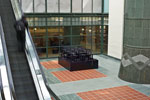works sited
"Foundered Planetarium"
Peter Harkawik
September 27th - November 17th, 2012
Foundered Planetarium: A Series of Facts
A planetarium is a situation in which a group of spectators assemble to sit in bucket seats, their vision trained upwards. They may or may not take notes. Gazing at a domed structure, the curvature of which mimics the curvature of the Earth, these spectators, who are people, encounter something situated curiously between information and entertainment. Prior to this encounter, a person who was likely selected for above-average vocal ability, has read a series of facts related to astronomy into a recording device. These facts, presented as the culmination of thousands of years of human inquiry, are played back while the spectators gaze at a "sky." Behind this "sky" is generally the real sky, perhaps hidden behind additional walls, floors, ceilings, or other structures. Occasionally, the stars themselves would be plainly visible, were it not for the fact that they were obscured by a ceiling, onto which more controlled, pedagogical "stars" are projected. These "stars" are comprised of a series of concealed lighting apparatuses controlled by a computer. A star is a celestial body which may or may not still be generating light. The light we perceive when we look at the stars is utterly unlike the light we perceive inside of a planetarium. It is, first and foremost, much older. Planetarium "stars" are beams of light which hit a surface in an artificially dark environment. Electricity, a small quantity of which may have been harvested from devices which convert light into energy, creates light, which passes through a substrate, and hits a surface. This light is perceived. A planetarium, then, necessarily entails a kind of bifurcated vision. We may conceive of two "views," which may not be experienced at the same time. ("Views" here functions as the indefinite participle, much like the "chews" of "peanut chews;" peanut chews as things which elicit chewing, are chewed, and remain chews prior to being chewed.) To sit outdoors and gaze into the night sky is to experience both depth and color of a wholly indeterminate nature. Wax holds color beneath its surface. Light, which generates heat, melts wax. The planetarium is also an animation. Animation is flat or extremely thin and comprised of a series of evolving forms or motifs. While animation may employ various disjunctive or nonlinear strategies, all animations entail change over time as it may be experienced from a fixed point. One way to animate a filmstrip is to lay it out on a long, glowing surface, and glide over it at a steady speed. Staring at a fixed point from a conveyor belt produces animation. An escalator is a vertically oriented conveyor belt which imposes a linear experience of space with optional agency (walking). Let's begin again. A planetarium is a group of people who look upwards and only upwards. These people sit in chairs. Below and around these chairs there may be the remnants of various human activities, for all intents and purposes unrelated to the educational transaction the planetarium provides. These people view up. Their view is that of the night sky, seen from a fixed point on the surface of the earth. Although each viewer might have a different vantage point relative to the ceiling of the planetarium, they do not see substantially different "stars," as one might, should she/he travel across the surface of the globe. The second view we concern ourselves with is that of the "stars," as it intersects that of the stars. Light travels up, hits a surface, and is reflected back down, to the point of the eyeball. The lie is finished at the point of perception.






